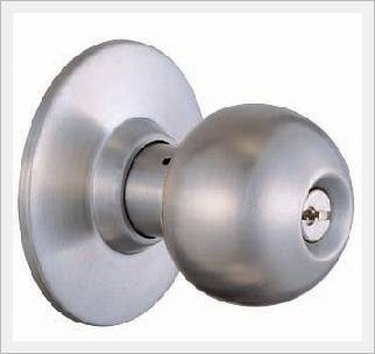
Simple Key Door Locks
The two most common types of locks in a home are simple key locks in a doorknob and deadbolt locks. Key locks contain a small cylinder that runs down the middle of the doorknob and into the door. Inside the cylinder are all the parts that work together with the key to lock or unlock the door. When the door is unlocked, a part called a tang is resting fully inside of the cylinder. When the door is locked, the tang is partially in and out of the cylinder.
How Door Locks Work
Video of the Day
A key is necessary to release the tang. The key turns the cylinder, which in turn turns something called a cam. The cam then releases a spring, which shoots the tang forward, securing the door to the wall. The tang cannot be withdrawn until the process is reversed. Some doorknobs are equipped with a button on the inside of the door, which, if pressed, will also release the spring, thus locking the door. These doorknobs are often designed so that, if the inside door knob is turned, the cylinder rotates in such a way that the tang is withdrawn without a key. In these cases, however, the outside door knob usually still needs a key to open it.
Video of the Day
What the Key Does
Cylinder locks are designed so that one key, and one key only, can rotate them, thus unlocking or locking the door. Inside a cylinder, there are several pairs of pins, along with tumblers. Each pin is of a different height. Each pair of pins rests in a shaft, which goes through the center of the cylinder and into the area around it. Very small springs are placed at the top of each shaft. These springs hold the pins in their respective placements. The bottom pins in each pair rest completely inside the plug when no key is present, and the upper pin in each pair sits halfway inside the plug, and halfway outside of it. This placement of the upper pin effectively secures the cylinder to the surrounding housing, preventing it from rotating. This means the door is locked. Keys have notches and these notches are made to line up with the pins and push each pin to a certain predetermined height. Placing a correct key into a lock will cause the notches on the key to push the pins up to the exact height that will cause the upper pins to be completely in the housing of the cylinder, and the lower pins to be completely in the surrounding area. This leaves a clean line between the pins, called a "shear line." Once the shear line is cleared, the cylinder is able to rotate, and the cam will release a spring which shoots the tang forward, thus unlocking the door. Keys that are inserted into the lock and do not have the correct pattern of notches will not push the pins to the correct height to clear the shear line. These pins will still be sitting partially in the housing and partially in the cylinder.